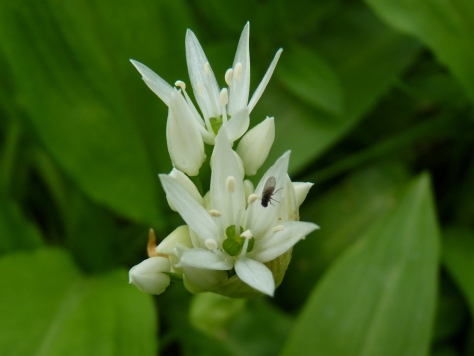 Wild Garlic is also known as Ramsons, Buckrams or Bear’s Garlic. Brown Bears are supposed to be very fond of it and so are Wild Boar. (The Latin name ursinum is derived from the Latin word Ursus meaning Bear)
Wild Garlic is also known as Ramsons, Buckrams or Bear’s Garlic. Brown Bears are supposed to be very fond of it and so are Wild Boar. (The Latin name ursinum is derived from the Latin word Ursus meaning Bear)
It is a beautiful native wildflower and a heady scent of garlic in the woods, it is also very good food.
The first leaves appear late in February.
 The leaves are best harvested in March and April before the flowers appear. I have heard that you can boil them but I don’t know why you would do that, they are an excellent addition to salad when served fresh and uncooked.
The leaves are best harvested in March and April before the flowers appear. I have heard that you can boil them but I don’t know why you would do that, they are an excellent addition to salad when served fresh and uncooked.
On my plate I have Wild Garlic, Garlic Mustard, Cuckooflower and primrose.
 Some care must be taken when collecting Wild Garlic. The leaves are easy to identify, they grow on single green stalks, they are quite large and lance shaped with smooth edges and most importantly, they smell of Garlic.
Some care must be taken when collecting Wild Garlic. The leaves are easy to identify, they grow on single green stalks, they are quite large and lance shaped with smooth edges and most importantly, they smell of Garlic.
Every year there are cases of poisonings concerning Wild Garlic, more so in Europe than the UK because foraging is more popular there. Poisonings occur because Wild Garlic grows in large patches and there will be other things growing in amongst it. In the next two pictures there is Wild Arum and then Dog’s Mercury growing amongst Wild Garlic, both potentially fatal.
 It is tempting to gather up this delicious herb by the handful but personally I select and check each leaf individually as I collect them. It is important to know what you are eating.
It is tempting to gather up this delicious herb by the handful but personally I select and check each leaf individually as I collect them. It is important to know what you are eating.
The flowers start to arrive in April. The flowers can now be eaten and added to salads in the same way as the leaves, they have a slightly stronger garlic flavour.
 At first they look like large uneven green buds.
At first they look like large uneven green buds.
 These are actually a pair of green bracts that are forming a case around an umbel that might carry as many as twenty flowers.
These are actually a pair of green bracts that are forming a case around an umbel that might carry as many as twenty flowers.



 The bracts turn papery and fall off as the umbel expands.
The bracts turn papery and fall off as the umbel expands.



 This is what was in each of those green cases.
This is what was in each of those green cases.
 Each flower on the umbel is composed of six white petals, it has six stamens and the pollen is pure white, there is a single style in the centre and at the base of that is the green, three lobed ovary.
Each flower on the umbel is composed of six white petals, it has six stamens and the pollen is pure white, there is a single style in the centre and at the base of that is the green, three lobed ovary.
 The seeds are edible and so the flowers can still be gathered as the seed starts to ripen. The bulbs are also edible but taking them removes the whole plant from the wild, they are small and best left in place to provide for future crops.
The seeds are edible and so the flowers can still be gathered as the seed starts to ripen. The bulbs are also edible but taking them removes the whole plant from the wild, they are small and best left in place to provide for future crops.
Wild Garlic is hermaphrodite and it is self fertile but is also pollinated by insects. It produces a lot of seed and spreads easily. It also produces little bulbs on the base of the original bulb and can be propagated by division.
Kingdom: Plantae
Order: Asparagales
Family: Amaryllidaceae
Genus: Allium
Species: Allium ursinum








